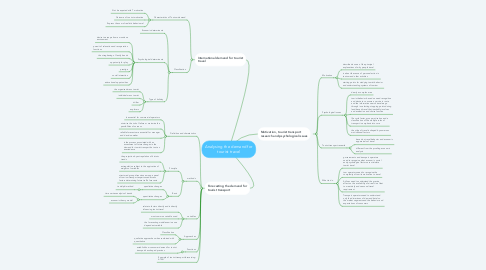
1. International demand for tourist travel
1.1. Characteristics of Tourism demand
1.1.1. Not be equated with T motivation
1.1.2. Outcome of tourist motivation
1.1.3. Express the sum of realistic behavioural
1.2. Classification
1.2.1. Economic determinants
1.2.2. Psychological determinants
1.2.2.1. desire to escape from a mundane environment
1.2.2.2. pursuit of relaxation and recuperation functions
1.2.2.3. the streghening of family bonds
1.2.2.4. oppotunity for play
1.2.2.5. prestige
1.2.2.6. social interaction
1.2.2.7. educational oppotunities
1.2.3. Type of holiday
1.2.3.1. the organised mass tourist
1.2.3.2. individual mass tourist
1.2.3.3. drifter
1.2.3.4. explorers
2. Forecasting the demand for tourist transport
2.1. Definition and charateristics
2.1.1. Is essential for commercial operators
2.1.2. minimize the risk of failure or maximize the possibilities of success
2.1.3. reliable forecasts are essential for manager and decision-maker
2.1.4. is the process associated with an assessment of future changes in the demand for tourist transport but not an exactsdence
2.2. methods
2.2.1. Principle
2.2.1.1. the projection by extrapolation of historic trends
2.2.1.2. extrapolation subject to the appication of weights of variables
2.2.1.3. structured group discussion among a panel of tourism transport experts used access factors determining future traffic forecasts
2.2.2. Basic
2.2.2.1. quanliative changes
2.2.2.1.1. te delphi method
2.2.2.2. quantitative changes
2.2.2.2.1. time serires analysis of trends
2.2.2.2.2. economic theory model
2.3. variables
2.3.1. relate to factors directly and indirectly infuencing tourist travel
2.3.2. most common variable used
2.3.3. the forecasting model examine one dependent variable
2.4. Approaches
2.4.1. Classification
2.4.2. qualiative approaches when combined with quantitative
2.5. Functions
2.5.1. establish how consumer demand for tourist transport has shaped previous
2.6. Example of tourist transport forecasting: ATAG
3. Motivation, tourist transport research and psychological issues
3.1. Motivation
3.1.1. described as one of the principal explanations of why people travel
3.1.2. is about the cause of personal action in tourism and other activities
3.1.3. starting points for studying tourist behavior and understanding systems of tourism
3.2. Psychological issues
3.2.1. dearly a complex area
3.2.2. tourist behavior based on need recognition and desire to consume a service in route and the information search travelers go through in selecting stopping points during land-based travel that inevitably involves and evaluation and choice function
3.2.3. life cycle factor, group motivation and a classification of the multiple roles of transport is emphasis into core
3.2.4. the style of travel is shaped by numerous motivational factors
3.3. Tourist transport research
3.3.1. based on travel behavior and economic apparaisals of travel
3.3.2. different from the prvailing economic analysis
3.4. What to do
3.4.1. gorvernments and transport operators need to recognize what economic, social and psychological factors are stimulate tourist travel
3.4.2. tour operators need to recognize the complexity of tourist motivation to travel
3.4.3. Airlines need to understand the precise effect on the availability of aircraft in a fleet to meet daily and seasonal travel requirement
3.4.4. Transport operators need to understand only the dimersions of demand but also the market segments and the behavior and expectations of consumers

